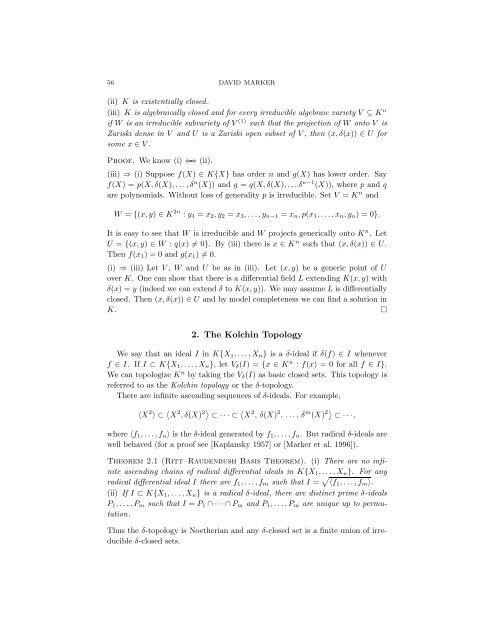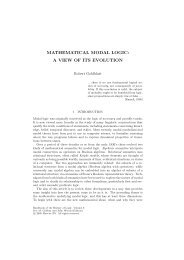Model Theory of Differential Fields
Model Theory of Differential Fields
Model Theory of Differential Fields
Create successful ePaper yourself
Turn your PDF publications into a flip-book with our unique Google optimized e-Paper software.
56 DAVID MARKER(ii) K is existentially closed.(iii) K is algebraically closed and for every irreducible algebraic variety V ⊆ K nif W is an irreducible subvariety <strong>of</strong> V (1) such that the projection <strong>of</strong> W onto V isZariski dense in V and U is a Zariski open subset <strong>of</strong> V , then (x, δ(x)) ∈ U forsome x ∈ V .Pro<strong>of</strong>. We know (i) ⇐⇒ (ii).(iii) ⇒ (i) Suppose f(X) ∈ K{X} has order n and g(X) has lower order. Sayf(X) = p(X, δ(X), . . . , δ n (X)) and g = q(X, δ(X), . . . δ n−1 (X)), where p and qare polynomials. Without loss <strong>of</strong> generality p is irreducible. Set V = K n andW = {(x, y) ∈ K 2n : y 1 = x 2 , y 2 = x 3 , . . . , y n−1 = x n , p(x 1 , . . . , x n , y n ) = 0}.It is easy to see that W is irreducible and W projects generically onto K n . LetU = {(x, y) ∈ W : q(x) ≠ 0}. By (iii) there is x ∈ K n such that (x, δ(x)) ∈ U.Then f(x 1 ) = 0 and g(x 1 ) ≠ 0.(i) ⇒ (iii) Let V , W and U be as in (iii). Let (x, y) be a generic point <strong>of</strong> Uover K. One can show that there is a differential field L extending K(x, y) withδ(x) = y (indeed we can extend δ to K(x, y)). We may assume L is differentiallyclosed. Then (x, δ(x)) ∈ U and by model completeness we can find a solution inK. □2. The Kolchin TopologyWe say that an ideal I in K{X 1 , . . . , X n } is a δ-ideal if δ(f) ∈ I wheneverf ∈ I. If I ⊂ K{X 1 , . . . , X n }, let V δ (I) = {x ∈ K n : f(x) = 0 for all f ∈ I}.We can topologize K n by taking the V δ (I) as basic closed sets. This topology isreferred to as the Kolchin topology or the δ-topology.There are infinite ascending sequences <strong>of</strong> δ-ideals. For example,〈X 2 〉 ⊂ 〈 X 2 , δ(X) 2〉 ⊂ · · · ⊂ 〈 X 2 , δ(X) 2 , . . . , δ m (X) 2〉 ⊂ · · · ,where 〈f 1 , . . . , f n 〉 is the δ-ideal generated by f 1 , . . . , f n . But radical δ-ideals arewell behaved (for a pro<strong>of</strong> see [Kaplansky 1957] or [Marker et al. 1996]).Theorem 2.1 (Ritt–Raudenbush Basis Theorem). (i) There are no infiniteascending chains <strong>of</strong> radical differential ideals in K{X 1 , . . . , X n }. For anyradical differential ideal I there are f 1 , . . . , f m such that I = √ 〈f 1 , . . . , f m 〉.(ii) If I ⊂ K{X 1 , . . . , X n } is a radical δ-ideal, there are distinct prime δ-idealsP 1 , . . . , P m such that I = P 1 ∩ · · · ∩ P m and P 1 , . . . , P m are unique up to permutation.Thus the δ-topology is Noetherian and any δ-closed set is a finite union <strong>of</strong> irreducibleδ-closed sets.
















